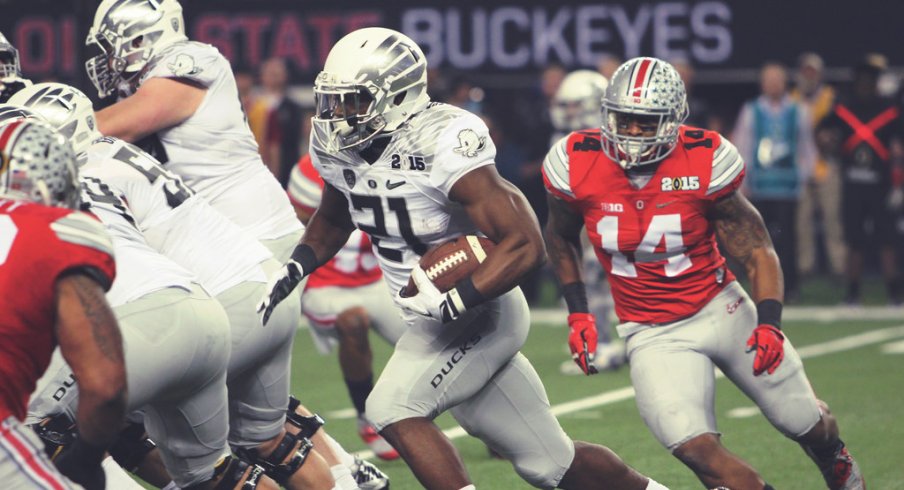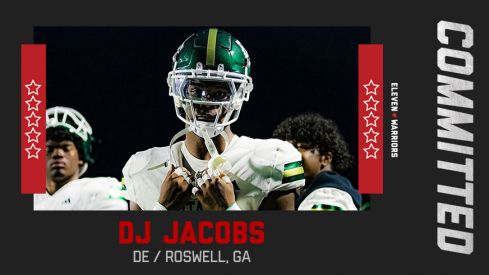For those that have been paying attention, either on this site or elsewhere, packaged plays have become all the rage in offensive meeting rooms, from high school to the NFL. While they can now be found in the playbooks of the Pittsburgh Steelers, Green Bay Packers, New England Patriots and others, the concept was first battle-tested and proven at the college level.
In case you may not be familiar, these plays are an extension of classic 'option' football wherein the quarterback reads a pre-determined defender to decide whether or not to hand the ball to his running back. However, where a classic option would leave the quarterback to keep the ball and run himself, these schemes call for the receivers to run short routes, allowing the QB to make a quick, open throw to the outside.
Often times, teams executing these options appear to be picking apart a defense in multiple different ways, rolling downfield quickly while actually running the same play over and over. For this reason, they're a perfect addition to an uptempo, no-huddle offense since there is no reason to re-group or substitute. In theory, all the offense needs to do is properly identify and read one defender over and over, making him wrong no matter what.
It should come as no surprise then, that one of the earliest adopters of the concept was former Oregon coach Chip Kelly, whose Philadelphia Eagles now regularly run multiple packaged concepts every Sunday. But as we all know, his philosophical impact is still felt in Eugene, where his former staff and players rode his blueprint for success all the way to the CFB Playoff championship game.
Heisman-winner Marcus Mariota ran the system to perfection, allowing both facets of the Ducks' offense to thrive. While it's impossible to know if every handoff or screen was a true option, we do know that when he handed off last fall, Oregon running backs averaged over five yards-per-carry. As if that wasn't good enough, when he did pull the ball to throw it, Mariota averaged 10 yards per attempt.
With a month to prepare, the Florida State defense was taken apart and left completely demoralized by this dual-threat attack in their semi-final matchup in the Rose Bowl. Seminole defensive ends and outside linebackers were made to look foolish (through no fault of their own) by Mariota as the Ducks rolled up well over 600 yards of total offense on the afternoon, split almost evenly between rush and pass yards.
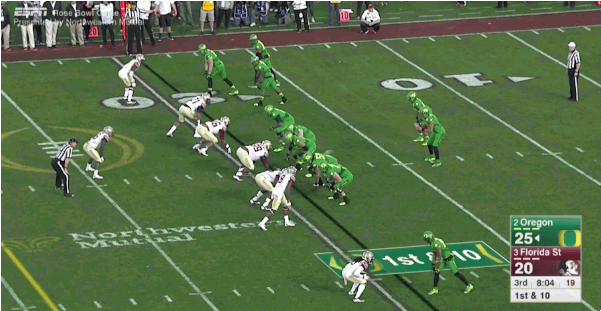
For the Buckeyes to take down this powerhouse, they'd have to limit the production of these plays, forcing Mariota and the Ducks to take a different path to pick up yards. When the Oregon offense is at it's most dangerous, they're able to pick up five yards on first down, staying ahead of the chains and instilling the threat of running a quick screen to pick up enough yards on later downs.
On many occasions against OSU, Oregon would call for a run/pass option with Mariota in the shotgun and two receivers to either side. The Ducks would attempt to attack the interior of the Ohio State defense with an inside zone run, while forcing both outside linebackers to decide between helping with the run or defending bubble screens to their side.
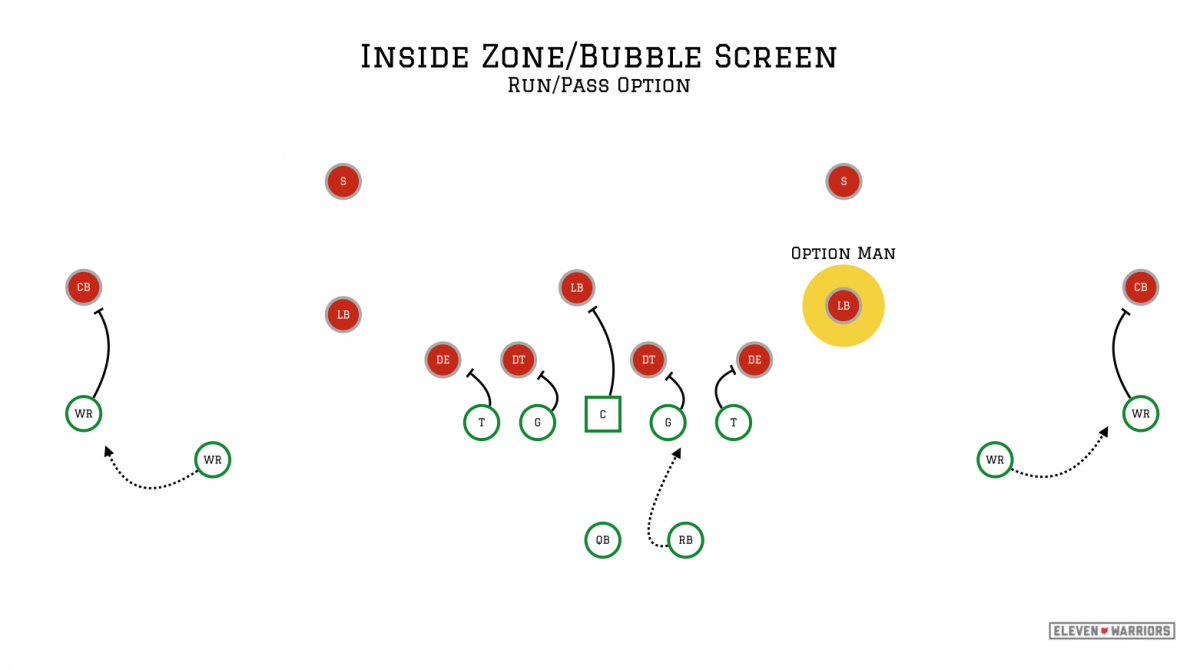
The initial results were positive for the Ducks, who ran this specific play three times on their very first drive of the game, highlighted by a 12-yard gain as the inside zone found a major hole in the play-side B gap.

It appears that Michael Bennett tried to cross the face of the right guard (#78) while Joey Bosa attacked the outside C gap, with both perhaps believing the B gap would be filled by linebacker Josh Perry, who was busy attacking the bubble screen to the outside and nowhere to be found.
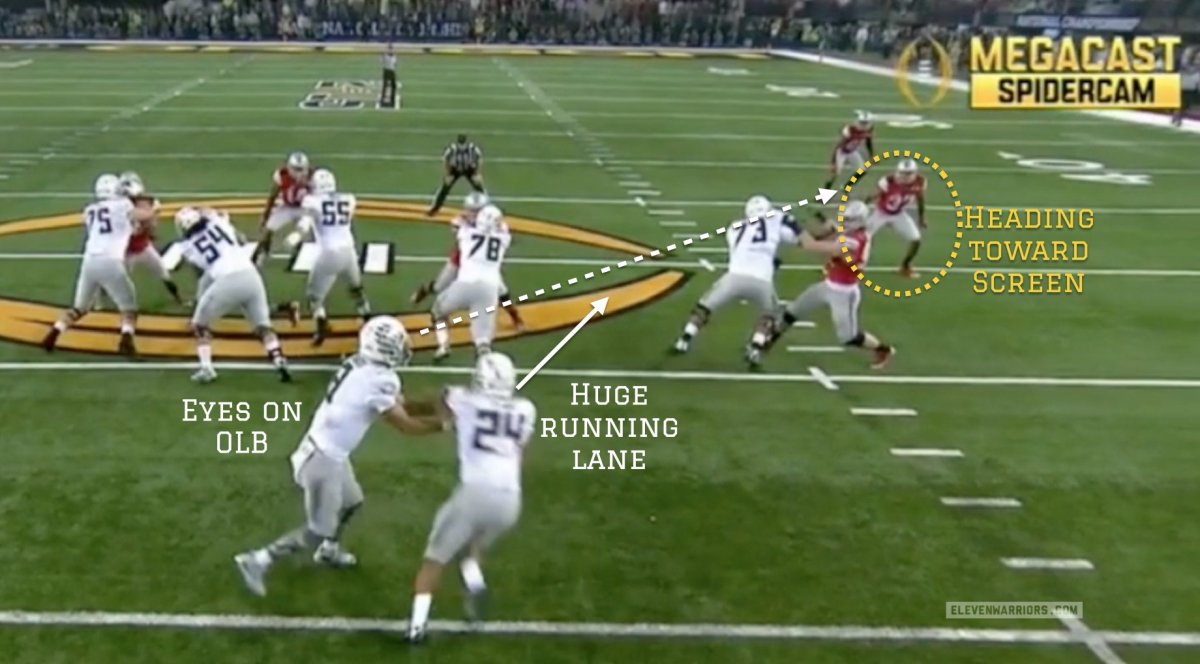
As we all remember, the Ducks marched right down the field on that initial drive, appearing to live up to their billing as an offensive juggernaut. However, they'd also shown their cards.
Defensive coordinators Chris Ash and Luke Fickell didn't throw out the baby with the bath water after that initial touchdown, instead making a simple adjustment to their defensive line. The Buckeye back seven was given the responsibility of taking away the screen, forcing Mariota to hand off as much as possible.
The OSU front would now 'pinch' on any run action, with all four down linemen attacking the inside gaps. The defensive tackles had the critical job of filling the A gaps between the center and guards, not looking to penetrate, but instead to occupy double-teams, leaving the middle linebacker free behind them.
Then, the ends were tasked with attacking the B between the guards and tackles, or at least squeezing the edges of the line inside, not allowing the tackles to kick the ends out (like they did to Bosa on the earlier example) or get upfield to the outside linebacker.
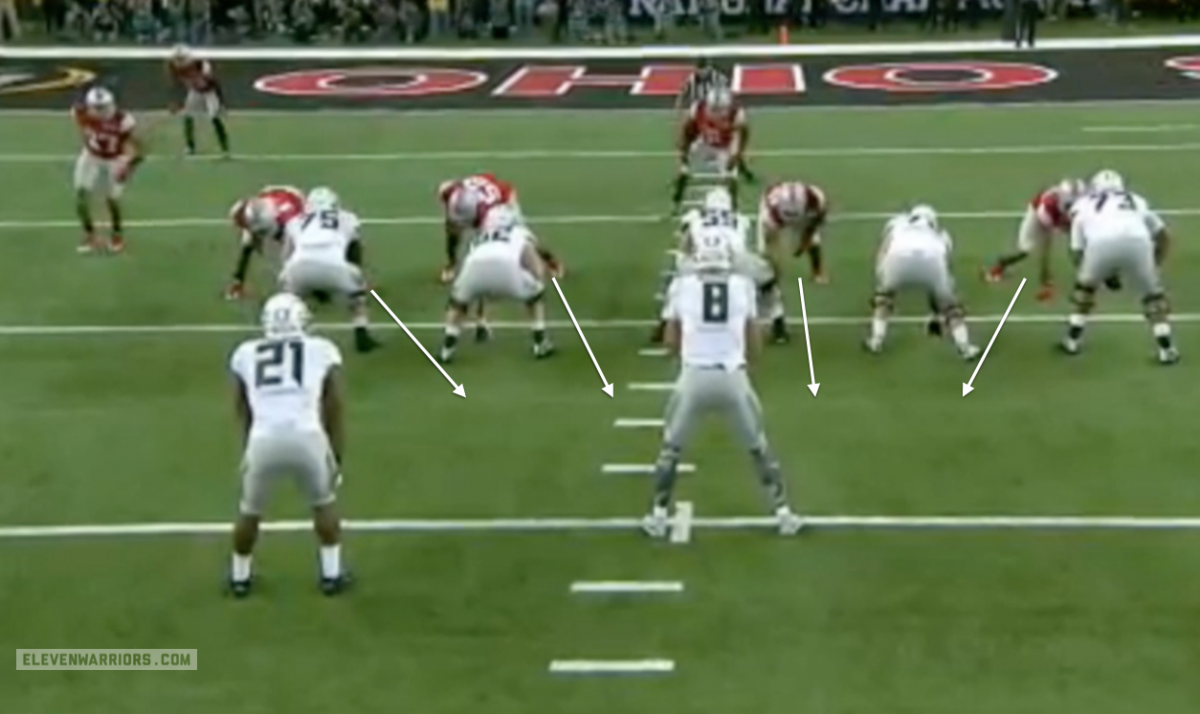
The results were felt immediately. Mariota still had his eyes on one outside linebacker (often Josh Perry, lined up to the same side as the running back), watching him dart over to cover the bubble screen, which Mariota only threw two times all night. As the running back took the handoff however, he found no such open gaps inside, thanks to the pinching OSU front.
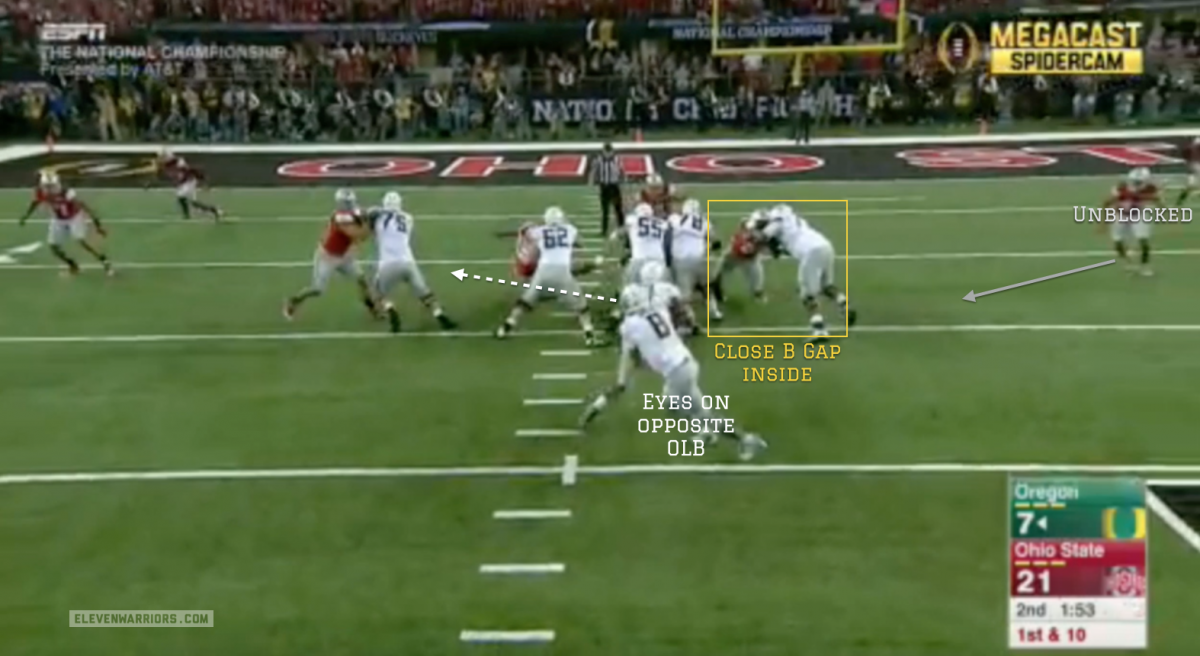
Instead, the back looked to bounce it outside, where he ran right into the waiting arms of the unblocked middle linebacker, as well as the backside outside linebacker, Darron Lee.

Although the Buckeyes had shown that they were up to the task when asked to cover a balanced formation, the Ducks began to experiment with formations over-loaded to one side. Though still looking to run between the tackles with the inside zone, the Ducks aligned three receivers and a tight end to the same side, setting up a flash screen to the outside receiver.
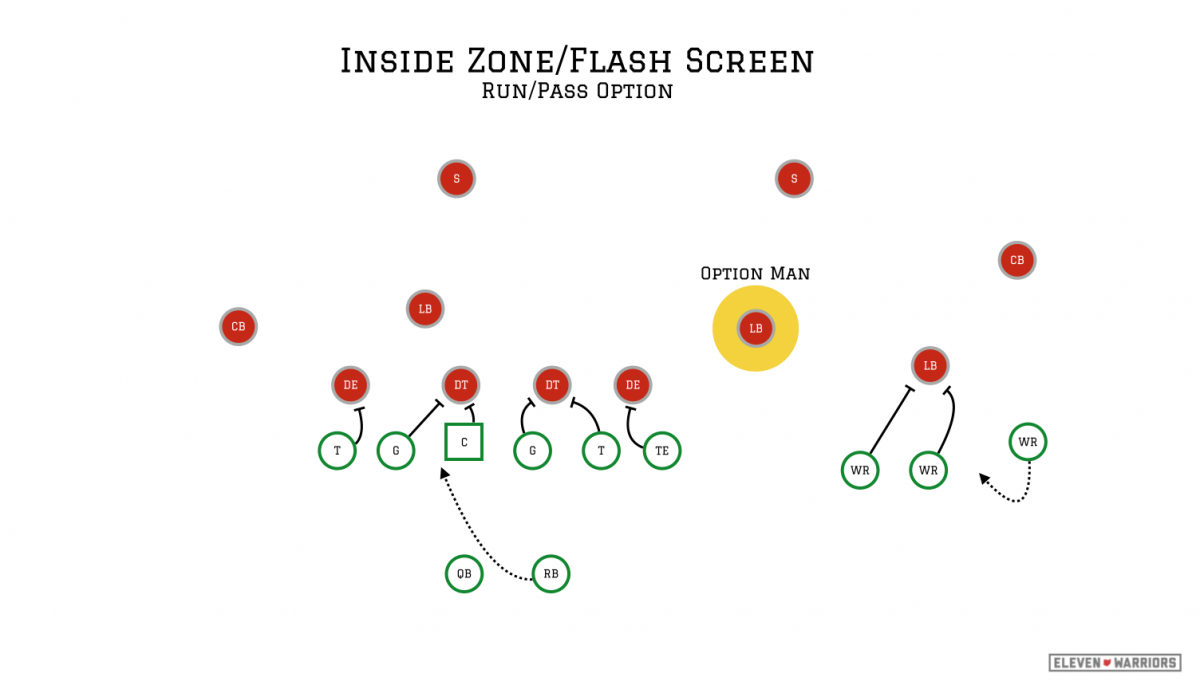
Ohio State responded not by moving both corners to the strong side of the field, instead shifting the linebackers over, turning the middle linebacker into an outside player, the weak-side linebacker into the middle backer, and rolling the cornerback up into the box, just outside the C gap.
With two linebackers out of the box and a tight end on the line, the Ducks have eight players inside to the Buckeyes' seven, giving them what appears to be a numbers advantage, especially with the running threat of the athletic Mariota. However, by taking away the screen-pass option, the OSU defense was dictating Mariota's decisions.
Knowing what an offense will run doesn't mean you can stop it, which is where the Buckeye D-line once again came up big. The big men up front now slanted away from the screen, once again not looking to penetrate as much as occupying blockers.
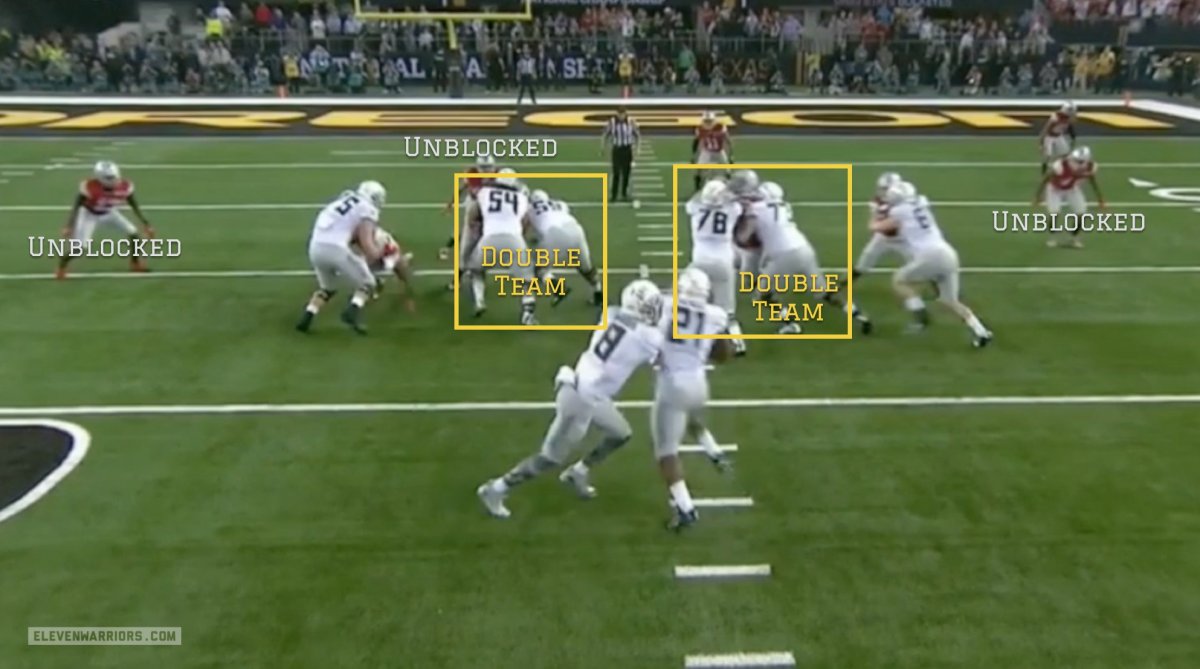
Though the Ducks had six blockers on the line, two Buckeyes forced double-teams, completely flipping the numbers to what effectively became a seven-to-six advantage in the direction of the scarlet and gray. This flip meant linebacker Curtis Grant was left completely free to make an easy tackle.

By doing so, Ash and Fickell were effectively daring Mariota to throw the screen, knowing the Ducks would be asking a wide receiver to block the play-making Lee in space, another clear mismatch in favor of the Buckeyes.

Though it seems odd at first, the Buckeyes had taken away the Ducks' horizontal passing game thanks to the efforts of the defensive line, leaving the Oregon offense to play catch-up without one of their favorite items in the toolbox. After running 13 packaged concepts in the first half, the Ducks largely abandoned it late in the game, running only five in the third quarter, and none at all in the fourth.
OSU had completely taken away the run/pass option by forcing the Ducks' hand when doing so. Knowing the strength of the Oregon offense was on the outside with their multiple receiving options, the Buckeyes were willing to bet on themselves in the battle of the trenches.
Oregon Run/Pass Options vs Ohio State
| Number of Plays | Yards-Per-Play | |
|---|---|---|
| run | 15 | 2.93 |
| PAss | 3 | 3.00 |
| Total | 18 | 2.94 |
Simply taking away the pass is not always the answer, however. The key to stopping any run/pass option is to determine where a defense is strongest, and force the offense to play toward that direction. Against the Ducks, that meant funneling the ball inside. With the loss of Michael Bennett, Steve Miller, and Rashad Frazier though, that could change this fall, especially against a team like Michigan State that features a veteran group of offensive linemen.
Whatever the case, offenses will continue to evolve, packaging new concepts together. But at the end of the day, the old saying remains just as relevant as ever: "Jimmys and Joes beat X's and O's."
